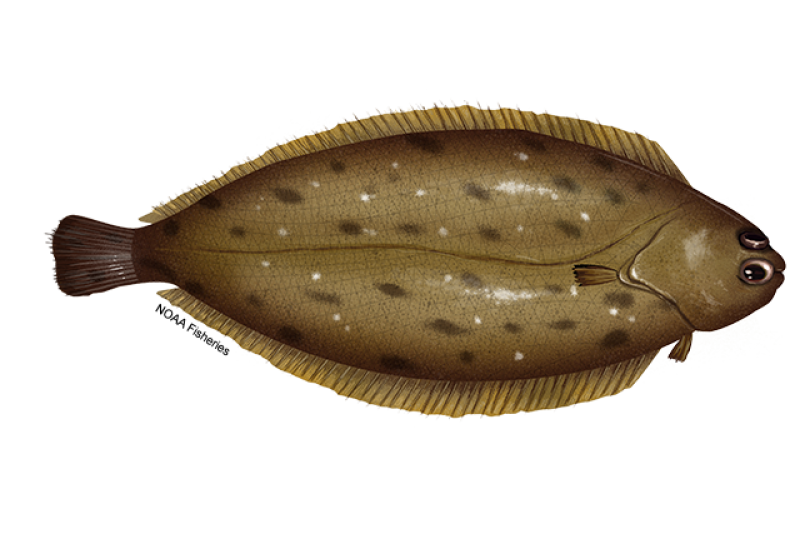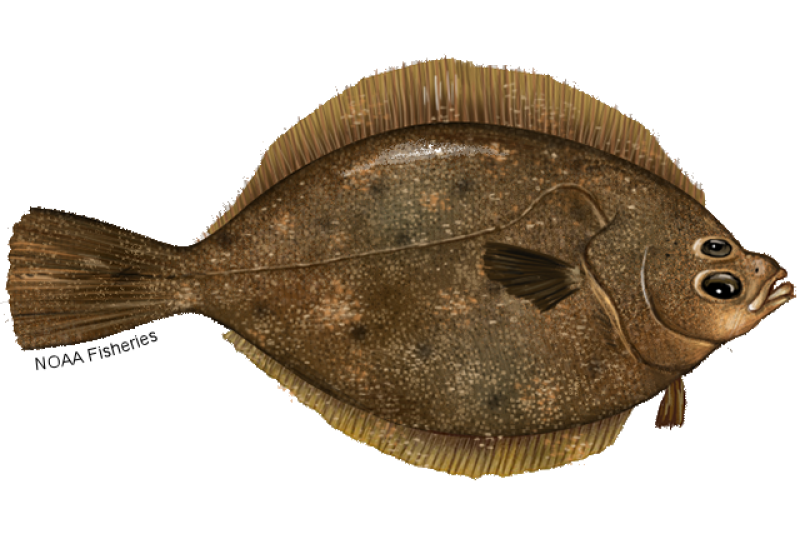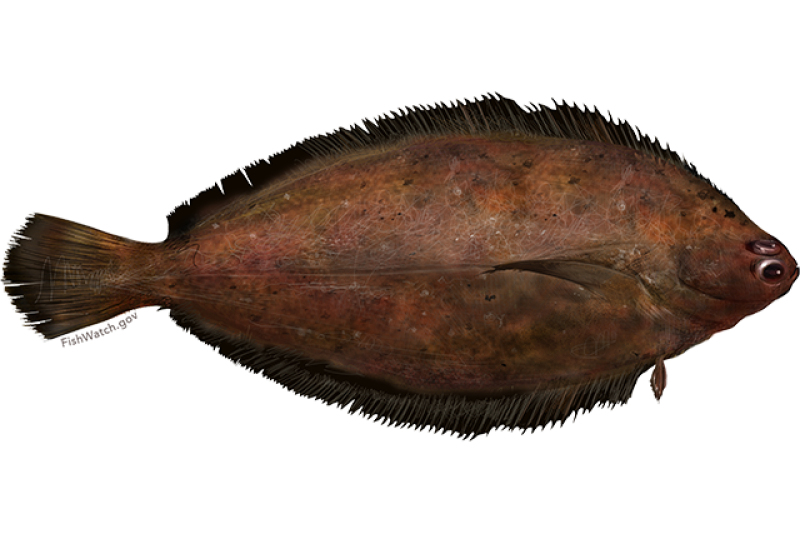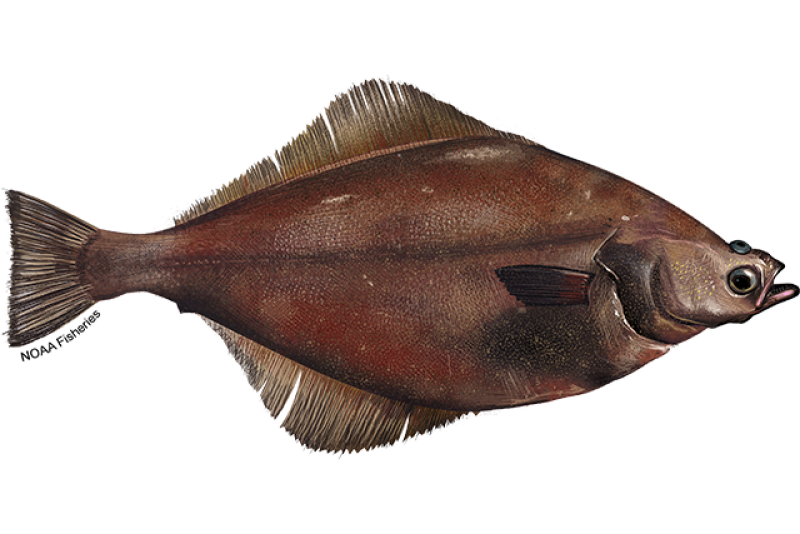 Dover sole. Credit: NOAA Fisheries
Dover sole. Credit: NOAA Fisheries
Dover sole. Credit: NOAA Fisheries
About the Species
 Dover sole. Credit: NOAA Fisheries
Dover sole. Credit: NOAA Fisheries
Dover sole. Credit: NOAA Fisheries
U.S. wild-caught Dover sole is a smart seafood choice because it is sustainably managed and responsibly harvested under U.S. regulations.

Population
The Pacific Coast stock and Gulf of Alaska Deepwater Flatfish Complex are not overfished.

Fishing Rate
Not subject to overfishing.

Habitat Impact
Area closures and gear restrictions protect habitats affected by some types of fishing gear used to harvest Dover sole.

Bycatch
Regulations are in place to minimize bycatch.
Population Status
- There are three stocks of Dover sole: Pacific coast, one stock contained in the Gulf of Alaska Deepwater Flatfish Complex, and one stock contained in the Bering Sea/Aleutian Islands Other Flatfish Complex. According to the most recent stock assessments:
- The Pacific coast stock is not overfished (2021 stock assessment) and not subject to overfishing based on 2022 catch data. Summary stock assessment information can be found on Stock SMART.
- Dover sole is the primary species contained in the Gulf of Alaska Deepwater Flatfish Complex and has been assessed, and the stock complex is not overfished based on the assessment of Dover sole (2023 stock assessment of Dover sole). The stock complex is not subject to overfishing based on 2023 catch data. Summary stock assessment information can be found on Stock SMART.
- Dover sole is managed as part of the Bering Sea/Aleutian Islands Other Flatfish Complex and the stock complex has been assessed, but there is not enough information to determine the population size so the overfished status is unknown (2020 stock assessment). This complex is not subject to overfishing based on 2023 catch data. Summary stock assessment information can be found on Stock SMART.
Appearance
- Dover sole are flatfish, with both of their eyes located on the right side of their head.
- Their mouths are small relative to their size.
- Their drab coloring helps them camouflage themselves on the ocean floor.
- In some areas, Dover sole are referred to as “slippery sole” because they excrete mucous onto their skin/scales, making them incredibly slippery and hard to pick up.
Biology
- Females grow faster and larger than males, up to 30 inches long, about 2 to 4 inches longer than males.
- Males can live up to 58 years, about 5 years longer than females.
- Dover sole spawn near the ocean floor in waters deeper than 1,440 feet. Spawning seasons vary by location:
- In the Gulf of Alaska from January to August.
- Off Oregon from November to April.
- In Puget Sound from January to March.
- Females produce between 52,000 to 266,000 eggs, which can be as large as 0.1 inches.
- Dover sole eggs are fertilized externally and are found in the upper part of the water column.
- Once hatched, larvae settle into deeper water, then travel inshore to find suitable nursery areas.
- Dover sole larvae usually settle to the bottom after a year of living in the upper water column, but some remain larvae for as long as 2 years.
- Scientists believe these “holdover” larvae delay settling to the bottom due to unfavorable environmental conditions.
- Dover sole feed during the daytime by sight and smell.
- Their mouths are well adapted for feeding on small invertebrates that live within ocean floor sediments.
- Larval Dover sole feed on small crustaceans, eggs, and larval crustaceans as well as plankton.
- Juveniles and adults feed on worms, bivalves, brittle stars, and small bottom-dwelling crustaceans.
- Seabirds and fish that live near the surface prey on larval Dover sole.
- Sharks, bottom-feeding marine mammals, Pacific cod, arrowtooth flounder, and sometimes sablefish feed on juveniles and adults.
Where They Live
Range
- Dover sole is found in the Pacific Ocean from the Bering Sea and western Aleutian Islands to southern Baja California.
Habitat
- Dover sole live near the ocean floor and prefer soft bottom habitat in waters 7 to 4,500 feet deep.
- They travel to deeper water as they age.
Fishery Management
- NOAA Fisheries and the Pacific Fishery Management Council manage the Dover sole fishery on the West Coast.
- Managed under the Pacific Coast Groundfish Fishery Management Plan:
- Limits on the number of permits and fishermen allowed.
- Limits on the minimum size of fish that may be harvested.
- Limit on how much may be harvested in one fishing trip.
- Certain seasons and areas are closed to fishing.
- Gear restrictions help reduce bycatch and impacts on habitat.
- A trawl rationalization catch share program includes:
- Catch limits based on the health of each fish stock and divided into shares that are allocated to individual fishermen or groups.
- These fishermen can decide how and when to catch their share – preferably when weather, markets, and business conditions are most favorable, allowing the fishery the flexibility to be more environmentally responsible, safer, more efficient, and more valuable.
- NOAA Fisheries and the North Pacific Fishery Management Council manage the Dover sole fishery in Alaska.
- Managed under the Gulf of Alaska Groundfish Fishery Management Plan:
- Total allowable catch is allocated by regulatory area (western, central, and 2 sub-areas of the eastern Gulf of Alaska).
- Managed under the Bering Sea/Aleutian Islands Groundfish Fishery Management Plan:
- Dover sole is managed as part of the other flatfish complex.
- In the Gulf of Alaska and Bering Sea:
- Fishermen must have a permit to participate in these fisheries, and the number of available permits is limited to control the amount of fishing.
- Managers set limits on how much Dover sole can be caught. Catch is monitored through record keeping, reporting requirements, and observer monitoring.
Harvest
- In 2023, commercial landings of Dover sole totaled 8.4 million pounds and were valued at $3.5 million, according to the NOAA Fisheries commercial fishing landings database.
- Most of the landings come from Oregon, California, and Washington State.
- Gear types, habitat impacts, and bycatch:
- Bottom trawls are used to catch Dover sole.
- Trawls that are used to harvest Dover sole can contact the ocean floor and impact habitats, depending on the characteristics of the ocean bottom and the size of the gear.
- Bottom trawls cause minimal damage to habitat when targeting Dover sole over soft, sandy, or muddy ocean bottoms off the West Coast and Alaska.
- In Alaska and on the West Coast, NOAA Fisheries and the regional fishery management councils have implemented large closed areas to protect sensitive rocky, cold-water coral and sponge habitats from bottom trawls.
- Vessel monitoring systems allow enforcement staff and fishery managers to monitor GPS locations of fishing activities to ensure vessels are complying with closed areas.
- In Alaska, there are limits on the amount of halibut that can be incidentally caught in groundfish fisheries. If the limit is reached, managers close the fishery for the remainder of the season.
Scientific Classification
- Dover sole is found in the Pacific Ocean from the Bering Sea and western Aleutian Islands to southern Baja California.
- Dover sole live near the ocean floor and prefer soft bottom habitat in waters 7 to 4,500 feet deep.
- They travel to deeper water as they age.
Fishery Management
- NOAA Fisheries and the Pacific Fishery Management Council manage the Dover sole fishery on the West Coast.
- Managed under the Pacific Coast Groundfish Fishery Management Plan:
- Limits on the number of permits and fishermen allowed.
- Limits on the minimum size of fish that may be harvested.
- Limit on how much may be harvested in one fishing trip.
- Certain seasons and areas are closed to fishing.
- Gear restrictions help reduce bycatch and impacts on habitat.
- A trawl rationalization catch share program includes:
- Catch limits based on the health of each fish stock and divided into shares that are allocated to individual fishermen or groups.
- These fishermen can decide how and when to catch their share – preferably when weather, markets, and business conditions are most favorable, allowing the fishery the flexibility to be more environmentally responsible, safer, more efficient, and more valuable.
- NOAA Fisheries and the North Pacific Fishery Management Council manage the Dover sole fishery in Alaska.
- Managed under the Gulf of Alaska Groundfish Fishery Management Plan:
- Total allowable catch is allocated by regulatory area (western, central, and 2 sub-areas of the eastern Gulf of Alaska).
- Managed under the Bering Sea/Aleutian Islands Groundfish Fishery Management Plan:
- Dover sole is managed as part of the other flatfish complex.
- In the Gulf of Alaska and Bering Sea:
- Fishermen must have a permit to participate in these fisheries, and the number of available permits is limited to control the amount of fishing.
- Managers set limits on how much Dover sole can be caught. Catch is monitored through record keeping, reporting requirements, and observer monitoring.
Harvest
- In 2023, commercial landings of Dover sole totaled 8.4 million pounds and were valued at $3.5 million, according to the NOAA Fisheries commercial fishing landings database.
- Most of the landings come from Oregon, California, and Washington State.
- Gear types, habitat impacts, and bycatch:
- Bottom trawls are used to catch Dover sole.
- Trawls that are used to harvest Dover sole can contact the ocean floor and impact habitats, depending on the characteristics of the ocean bottom and the size of the gear.
- Bottom trawls cause minimal damage to habitat when targeting Dover sole over soft, sandy, or muddy ocean bottoms off the West Coast and Alaska.
- In Alaska and on the West Coast, NOAA Fisheries and the regional fishery management councils have implemented large closed areas to protect sensitive rocky, cold-water coral and sponge habitats from bottom trawls.
- Vessel monitoring systems allow enforcement staff and fishery managers to monitor GPS locations of fishing activities to ensure vessels are complying with closed areas.
- In Alaska, there are limits on the amount of halibut that can be incidentally caught in groundfish fisheries. If the limit is reached, managers close the fishery for the remainder of the season.
Scientific Classification
| Kingdom | Animalia | Phylum | Chordata | Class | Actinopterygii | Order | Pleuronectiformes | Family | Pleuronectidae | Genus | Microstomus | Species | pacificus |
|---|
Last updated by NOAA Fisheries on 03/21/2025
Featured News
 Offloading frozen Pacific cod from a catcher-processor vessel in Dutch Harbor, Alaska. Credit: NOAA Fisheries / Paul Hillman.
Offloading frozen Pacific cod from a catcher-processor vessel in Dutch Harbor, Alaska. Credit: NOAA Fisheries / Paul Hillman.
Economic Snapshot Shows Alaska Seafood Industry Suffered $1.8 Billion Loss 2022–2023
 Chef Rob's Pulled Opah Sandwich. Credit: Sam Wells.
Chef Rob's Pulled Opah Sandwich. Credit: Sam Wells.


Seafood Facts

Is Dover Sole Sustainable?
U.S. wild-caught Dover sole is a smart seafood choice because it is sustainably managed and responsibly harvested under U.S. regulations.
Availability
Year-round.
Source
U.S. wild-caught from Alaska to California.
Taste
Mild and sweet.
Texture
Dense and firm.
Color
Raw meat is glistening white, and cooked meat is white.
Health Benefits
Dover sole is an excellent source of low-fat protein and calcium.
Nutrition Facts
Servings: 1; Serving Weight: 100 g (raw); Calories: 91; Protein: 18.84 g ; Total Fat: 1.19 g; Total Saturated Fatty Acids: 0.283 g; Carbohydrate: 0 g; Total Sugars: 0 g; Total Dietary Fiber: 0 g; Cholesterol: 48 mg; Selenium: 32.7 mcg; Sodium: 81 mgMore Information
Sole Recipes
Looking for some ways to add sole into your rotation? If you need some cooking inspiration, browse these recipes for citrus sole with tahini drizzle, sole sliders, and more!

Last updated by NOAA Fisheries on 03/21/2025
Seafood News
 Celebrate Culinary Arts Month with a sustainable seafood recipe for every month of the year.
Celebrate Culinary Arts Month with a sustainable seafood recipe for every month of the year.
What Your Birth Month Says About Your Next Seafood Recipe
 Fresh-caught taʻape on ice. Credit: Conservation International Hawaiʻi.
Fresh-caught taʻape on ice. Credit: Conservation International Hawaiʻi.
Reducing Waste and Feeding Communities in Hawaiʻi with a Whole Fish Approach
 Chef Tyler Hadfield’s Curried Skate Wings with Tomato-Masala Chutney
Chef Tyler Hadfield’s Curried Skate Wings with Tomato-Masala Chutney
Ring In the New Year With These Crowd-Favorite Seafood Recipes
 NOAA Fisheries, in collaboration with Blue Ocean Mariculture, is conducting a multi-year pilot study to evaluate observational methods and tools for studying Hawaiian monk seal behavior. Courtesy of Blue Ocean Mariculture
NOAA Fisheries, in collaboration with Blue Ocean Mariculture, is conducting a multi-year pilot study to evaluate observational methods and tools for studying Hawaiian monk seal behavior. Courtesy of Blue Ocean Mariculture





